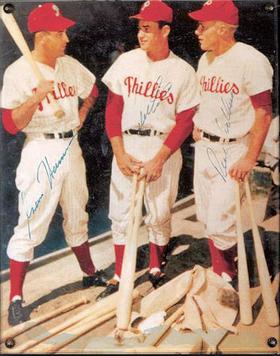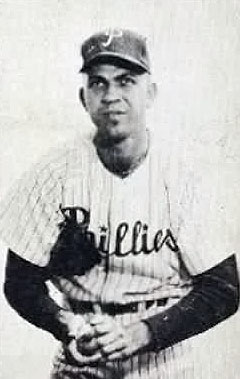
Extra innings is the extension of a baseball or softball game in order to break a tie.
The following are the baseball events of the year 2004 throughout the world.

The 1952 World Series featured the 3-time defending champions New York Yankees beating the Brooklyn Dodgers in seven games. The Yankees won their 4th consecutive title, tying the mark they set in 1936–1939 under manager Joe McCarthy, and Casey Stengel became the second manager in Major League history with 4 consecutive World Series championships. This was the Yankees' 15th World Series championship win, and the 3rd time they defeated the Dodgers in 6 years.
The 1947 World Series matched the New York Yankees against the Brooklyn Dodgers. The Yankees won the Series in seven games for their 11th World Series championship in team history. Yankees manager Bucky Harris won the Series for the first time since managing the Washington Senators to their only title in 1924, a gap of 23 years, the longest between World Series appearances in history.

The 1955 World Series matched the Brooklyn Dodgers against the New York Yankees, with the Dodgers winning the Series in seven games to capture their first championship in franchise history. It would be the only Series the Dodgers won while based in Brooklyn, as the team relocated to Los Angeles after the 1957 season. This was the fifth time in nine years that the Yankees and the Dodgers met in the World Series, with the Yankees having won in 1947, 1949, 1952, and 1953; the Yankees would also win in the 1956 rematch.
The following are the baseball events of the year 2003 throughout the world.
The following are the baseball events of the year 2002 throughout the world.
The following are the baseball events of the year 2001 throughout the world.

Carroll Walter"Whitey"Lockman was a left-handed hitting first baseman and outfielder, coach, manager and front office executive in Major League Baseball.

Milton Joseph Stock was an American third baseman in Major League Baseball from 1913 through 1926. The Chicago native played for the New York Giants, Philadelphia Phillies, Brooklyn Robins and St. Louis Cardinals. Over 14 MLB seasons, he played in 1,628 games and amassed 1,806 hits, with a .289 lifetime batting average and 155 stolen bases. Stock stood 5 feet 8 inches (1.73 m) tall, weighed 154 pounds (70 kg) and threw and batted right-handed.

Edward Jack Roebuck was an American professional baseball relief pitcher and scout, who played in Major League Baseball (MLB) for 11 seasons for the Brooklyn / Los Angeles Dodgers, Washington Senators and Philadelphia Phillies. He appeared in the World Series with the Dodgers in 1955 and 1956. During his playing days, Roebuck stood 6 ft 2 in (1.88 m), weighing 185 lb (84 kg). He threw and batted right-handed.
The 1957 Cleveland Indians season was a season in American baseball. The team finished sixth in the American League with a record of 76–77, 21½ games behind the New York Yankees
The 1951 New York Giants season was the franchise's 69th season and saw the Giants finish the regular season in a tie for first place in the National League with a record of 96 wins and 58 losses. This prompted a three-game playoff against the Brooklyn Dodgers, which the Giants won in three games, clinched by Bobby Thomson's walk-off home run, a moment immortalized as the Shot Heard 'Round the World. The Giants, however, lost the 1951 World Series to the New York Yankees in six games.

The 1950 Philadelphia Phillies won the National League pennant by two games over the Brooklyn Dodgers. Nicknamed the "Whiz Kids" because of the youth of their roster, they went on to lose the World Series to the New York Yankees in four straight games.
The 1949 Major League Baseball season was contested from April 18 through October 15, 1949. Both the American League (AL) and National League (NL) had eight teams, with each team playing a 154-game schedule. The New York Yankees won the World Series over the Brooklyn Dodgers in five games. Ted Williams of the Boston Red Sox and Jackie Robinson of the Dodgers won the Most Valuable Player Award in the AL and NL, respectively.

The Giants–Yankees rivalry is a Major League Baseball rivalry between the San Francisco Giants of the National League and the New York Yankees of the American League. It was particularly intense when both teams not only inhabited New York City but also, for a time, the same ball park. During that era the opportunities for them to meet could only have been in a World Series. Both teams kicked off the first Subway Series between the two leagues in 1921.

Andrew Viggo Hansen, Jr., nicknamed "Swede", was a right-handed pitcher in Major League Baseball. In a nine-season career, he played for the New York Giants and the Philadelphia Phillies. Hansen was officially listed as standing 6 feet 3 inches (191 cm) and weighing 185 pounds (84 kg). He was nicknamed Swede despite being of Danish ancestry, according to The Sporting News' Baseball Register.
The 1946 National League tie-breaker series was a best-of-three playoff series that extended Major League Baseball's (MLB) 1946 regular season to decide the winner of the National League (NL) pennant. The games were played on October 1 and October 3, 1946, between the St. Louis Cardinals and Brooklyn Dodgers. It was necessary after both teams finished the season with identical win–loss records of 96–58. This was the first ever tie-breaker series in MLB history. The Cardinals won the regular season series, 16–8.
The 1951 National League tie-breaker series was a best-of-three playoff series that extended Major League Baseball's (MLB) 1951 regular season to decide the winner of the National League (NL) pennant. The games were played on October 1, 2, and 3, 1951, between the New York Giants and Brooklyn Dodgers. It was necessary after both teams finished the season with identical win–loss records of 96–58. It is most famous for the walk-off home run hit by Bobby Thomson of the Giants in the deciding game, which has come to be known as baseball's "Shot Heard 'Round the World".










